Denitrification catalysts are the core part of SCR technology and determine the denitrification efficiency and economy of the SCR system, with construction costs accounting for more than 20% of the cost of flue gas denitrification projects and operating costs accounting for more than 30%. In recent years, developed countries such as the US, Japan and Germany have continued to invest large amounts of human, material and financial resources in research and development of high efficiency, low cost flue gas denitrification catalysts, with emphasis on the protection of intellectual property rights in the process of catalyst patent technology, technology transfer and production licensing.
The initial catalysts were metal-based catalysts such as Pt-Rh and Pt, with monolithic ceramics such as alumina as the carrier, which had the characteristics of higher activity and lower reaction temperature, but the expensive price limited their application in power plants.
Therefore, since the late 1960s, three Japanese companies, Hitachi, Mitsubishi and Takeda Chemical, have developed TiO2-based catalysts through continuous research and development and have gradually replaced the Pt-Rh and Pt series catalysts. The composition of this type of catalyst is mainly composed of metal oxides such as V2O5 (WO3), Fe2O3, CuO, CrOx, MnOx, MgO, MoO3, NiO or a mixture that plays a combined role, usually with TiO2, Al2O3, ZrO2, SiO2, activated carbon (AC), etc. as the carrier, and the reducing agent such as liquid ammonia or urea in the SCR system to reduce It is now the mainstream catalyst for SCR denitrification applications in power plants.
There are three types of catalysts: plate, honeycomb and corrugated plate. All three catalyst types have a proven track record in coal-fired SCR, with the plate and honeycomb types being more common and the corrugated plate type being less common.
The design of the catalyst is to select a catalyst with a certain reaction area to meet the design requirements of the basic SCR performance such as denitrification efficiency and ammonia escape rate under the conditions of flue gas flow, temperature, pressure and composition at the outlet of the coal economiser; its anti-blocking and anti-wear performance is the key to ensure the long-term safe and stable operation of the SCR equipment in an environment with variable ash conditions.

In terms of anti-clogging of ash, for a given reactor cross-section, the plate catalyst has the largest through-flow area for the same catalyst pitch, generally above 85%, the honeycomb catalyst is second with a through-flow area generally around 80% and the corrugated plate catalyst has a similar through-flow area to the honeycomb catalyst. Under the same design conditions, a properly selected honeycomb catalyst with a large pitch can have an anti-clogging effect close to that of the plate catalyst. In terms of structure, the plate catalyst has the smallest number of wall angles and the largest circulation area, making it the least likely to block ash; the honeycomb catalyst has an average circulation area, but the wall angles of each catalyst are at 90° right angles, which can cause ash bridging and blockage in adverse flue gas conditions; the corrugated plate catalyst has an average circulation cross-sectional area, but the wall angles are small and the number is relatively The corrugated plate catalyst has an average flow cross-sectional area, but has a small wall angle and a relatively large number of corrugated plates.
